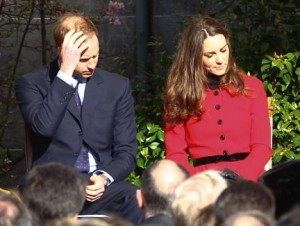According to the UK’s Glamour Beauty, Kate Middleton’s hair is “bouncy, shiny [and] basically perfect”. Prince William, on the other hand, could use some hair….err…help! While many people consider hair loss to be a “male” issue, it commonly affects women as well. In fact, excessive hair loss affects more than 30 million women, or 15% of all women in the US alone. The good news is that in women, hair loss may be related to hormonal or medical causes that can be reversible. On the contrary, [poor William!] men’s hair loss is typically genetic. or hereditary and irreversible. Patterns of hair loss in men and women differ as well. While men’s hair loss is typically localized to the temple, the crown or the “bald spot” on the top of the head, in women there is more often a diffuse thinning throughout the scalp, or a high hairline.
The most common medical problem causing  thinning and balding in women is related to excess male hormone (androgen) and is called androgenic alopecia. It may come as a surprise to some, but male hormone is typically present in women, albeit in small quantities. When those levels rise abnormally, the hair growth cycle will be adversely affected: the hair follicle will shrink over time and die, or become incapable of producing and maintaining healthy hair growth.
thinning and balding in women is related to excess male hormone (androgen) and is called androgenic alopecia. It may come as a surprise to some, but male hormone is typically present in women, albeit in small quantities. When those levels rise abnormally, the hair growth cycle will be adversely affected: the hair follicle will shrink over time and die, or become incapable of producing and maintaining healthy hair growth.
Alopecia areata is another common medical cause of hair loss in women. It is an autoimmune issue characterized by patches of hair loss, but often successfully treated with steroids. Hormonal fluctuations with pregnancy, post-pregnancy and menopause, as well as those hormonal changes associated with medications like the oral contraceptive, can contribute to hair thinning and balding as well. These and other medical causes like anemia, thyroid problems. physical or mental stress and crash or poor diets can lead to an insufficient quantity of the building blocks necessary for the growth and maintenance of healthy hair. Non-medical factors causing excessive hair loss are a growing concern. Hair straightening procedures like the Brazilian Blow-Out or Japanese Straightening can cause thinning and balding. Overstyling with frequent blow-drying, hair coloring, perming or processing be problematic, as can hair extensions, tight ponytails, braids and corn rows that can lead to tension alopecia with premature breakage and tearing of the hair from its follicle.
































 Take, for example, a child with protruding ears. Ear pinning (otoplasty) can restore the ear size, shape, and position to normalcy. After the age of six, otoplasty is safe, fast, and virtually painless. So why subject a child to a lifetime of “Dumbo” jokes? An otoplasty in an otherwise physically, emotionally, and socially healthy child can be a surefire way to prevent bullying. The same is true of exaggerated nasal features. Oversized, crooked, or oddly shaped noses are often a source of relentless teasing among children. Surgery that restores normal nasal structure and function has long been accepted by well-adjusted teens, their parents, and doctors, so why stand by and watch a child experience a painful loss of confidence? While surgeries to improve the appearance of a child’s ears or nose have long been popular, a newer cosmetic procedure is also on the rise. Those who suffer from unwanted hair, such as girls with upper lip hair or thick sideburns, may want a lasting solution to avoid being taunted by their peers. Laser hair removal is now becoming a more common alternative to waxing, depilation creams, and the dreadful shaving.
Take, for example, a child with protruding ears. Ear pinning (otoplasty) can restore the ear size, shape, and position to normalcy. After the age of six, otoplasty is safe, fast, and virtually painless. So why subject a child to a lifetime of “Dumbo” jokes? An otoplasty in an otherwise physically, emotionally, and socially healthy child can be a surefire way to prevent bullying. The same is true of exaggerated nasal features. Oversized, crooked, or oddly shaped noses are often a source of relentless teasing among children. Surgery that restores normal nasal structure and function has long been accepted by well-adjusted teens, their parents, and doctors, so why stand by and watch a child experience a painful loss of confidence? While surgeries to improve the appearance of a child’s ears or nose have long been popular, a newer cosmetic procedure is also on the rise. Those who suffer from unwanted hair, such as girls with upper lip hair or thick sideburns, may want a lasting solution to avoid being taunted by their peers. Laser hair removal is now becoming a more common alternative to waxing, depilation creams, and the dreadful shaving.